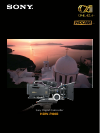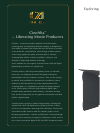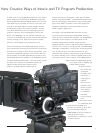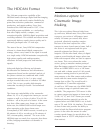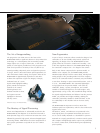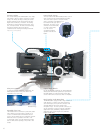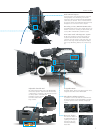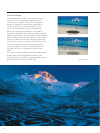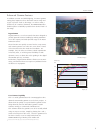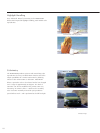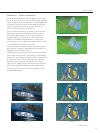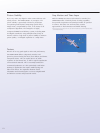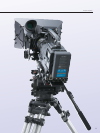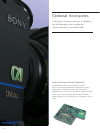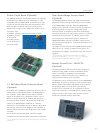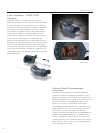
10
Motion-capture for
Cinematic Image
Making
Creative Versatility
This is the area where film and video have,
up until now, differed most. Every film camera
exposes a succession of still images (most
usually 24 frames per second) that, when
projected, effectively reproduce motion.
Because of the time required for a film
transport to move from frame to frame, half of
the action is not registered and this gives
material originated on film its specific
footprint. On the other hand, many of digital
cameras record interlaced images where two
fields with temporal offset are used to capture
one frame. This covers almost the entire
action, giving a smoother motion portrayal
than film images captured at lower frame rate.
When an HDW-F900R is set to a 24P frame
rate and with a shutter speed of 1/48 second,
it captures moving pictures in precisely the
same manner as the film camera and produces
results with the same motion footprint as
footage shot on film. The overall result is
comparable to 35 mm film origination.
As well as a 24P frame rate, the HDW-F900R
has a unique range of optional frame rates
available. The progressive CCD sensor is able
to capture progressive images at frame rates at
23.98, 24, 25, and 29.97 frames per second.
Traditional interlace material can also be
captured when an HDW-F900R is set to field
rates of 50, and 59.94 Hz interlace. The extent
of these frame rates provides the ability to
shoot in both the film and television program
genres. It also offers the means for some
creative speed change for special effects (for
example shoot at 29.97P and playback at 24P
slow motion).
4
The 24-frame progressive capability of the
HDCAM format converges digital and film imaging,
offering a new and novel creative flexibility for
prime time television production, commercial
production, and movie-making. Since Sony
introduced the HDCAM format in 1997, it has
been field proven worldwide, as a technology
that offers highly mobile, compact, and
exceptional-quality 1080/60i digital acquisition and
recording solutions. This reliable and robust format
consistently delivers superb picture quality and is
efficiently packaged onto 1/2-inch tape.
The state-of-the-art, Sony HDCAM compression
scheme is a frame-based digital compression
strategy, where every frame of the signal is treated
as a single entity. HDCAM maintains exceptionally
high picture quality and multi-generation
robustness for both progressive and interlace
signals.
Advanced digital pre-filtering and dynamic
bit-allocation for luminance and chrominance
components (based on the statistical analysis of
the picture content) are combined with a mild
compression ratio of 4.4 to 1 to give a total
on-tape recorded data rate of a modest 185 Mb/s
at 60i. This, in turn, provides high-integrity
camcorder recording in hostile environmental
conditions.
The frame rate switchability of the camcorder
allows 24, 25 or 30 progressive frames per second
capture as well as a choice of either 50 or 60 Hz
interlace – all at the push of a button. In the same
way that a film camera runs longer at a lower
frame rate, the HDW-F900R records longer runs
when operating at the lower frame rates.
Consequently a BCT-40HD cassette, records up to
40 minutes of 60i or records up to 50 minutes of
24P, cinema-quality, material. The costs of the
HDCAM tapes are much less expensive than those
of film, bringing tremendous cost benefits in
shooting.
The HDCAM Format



